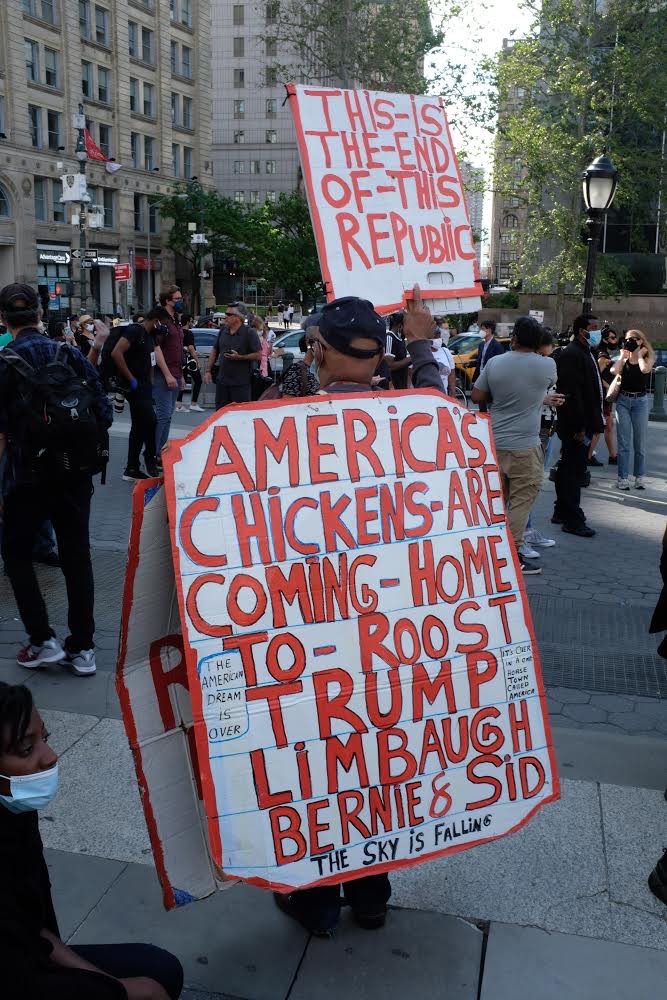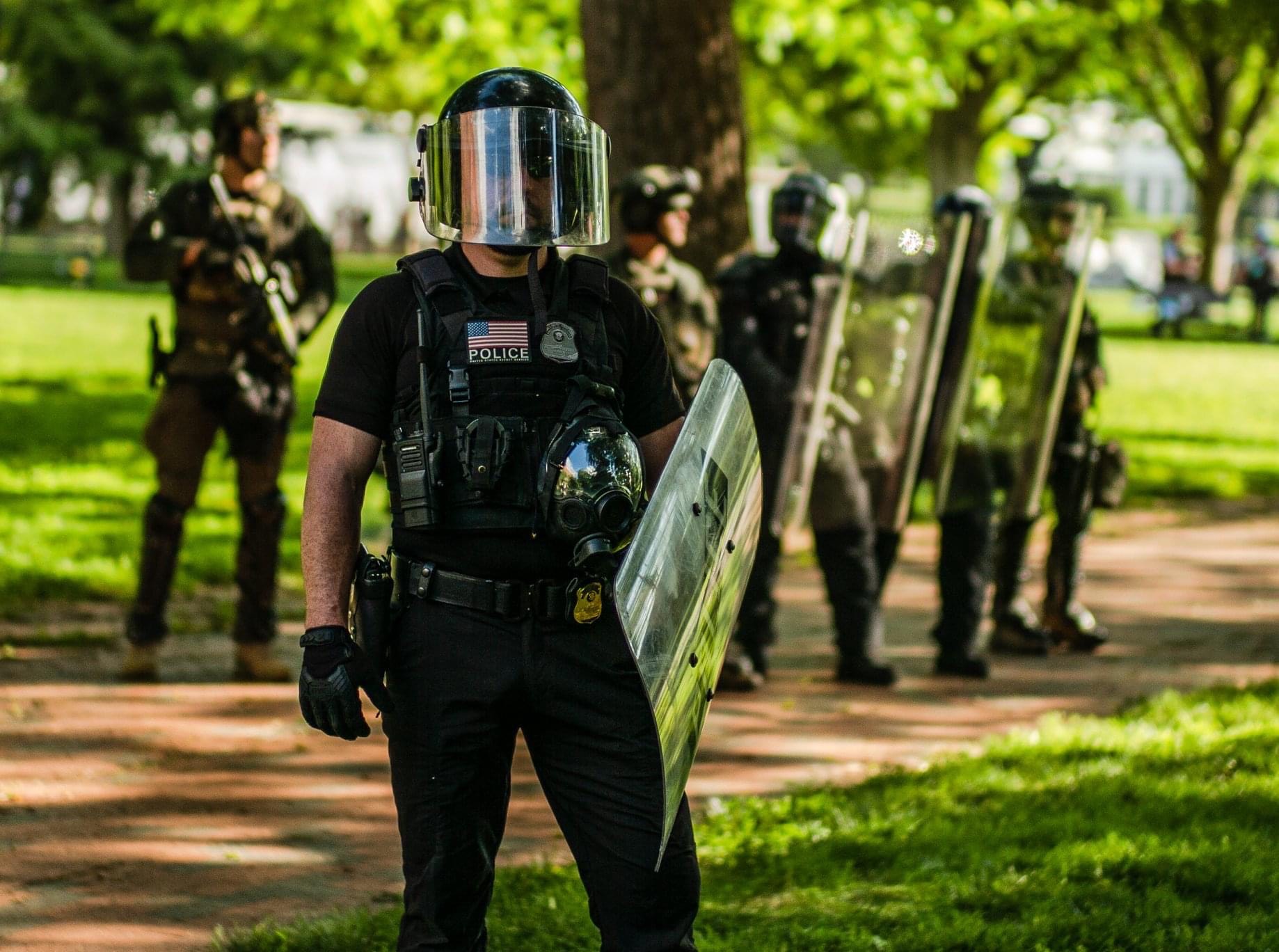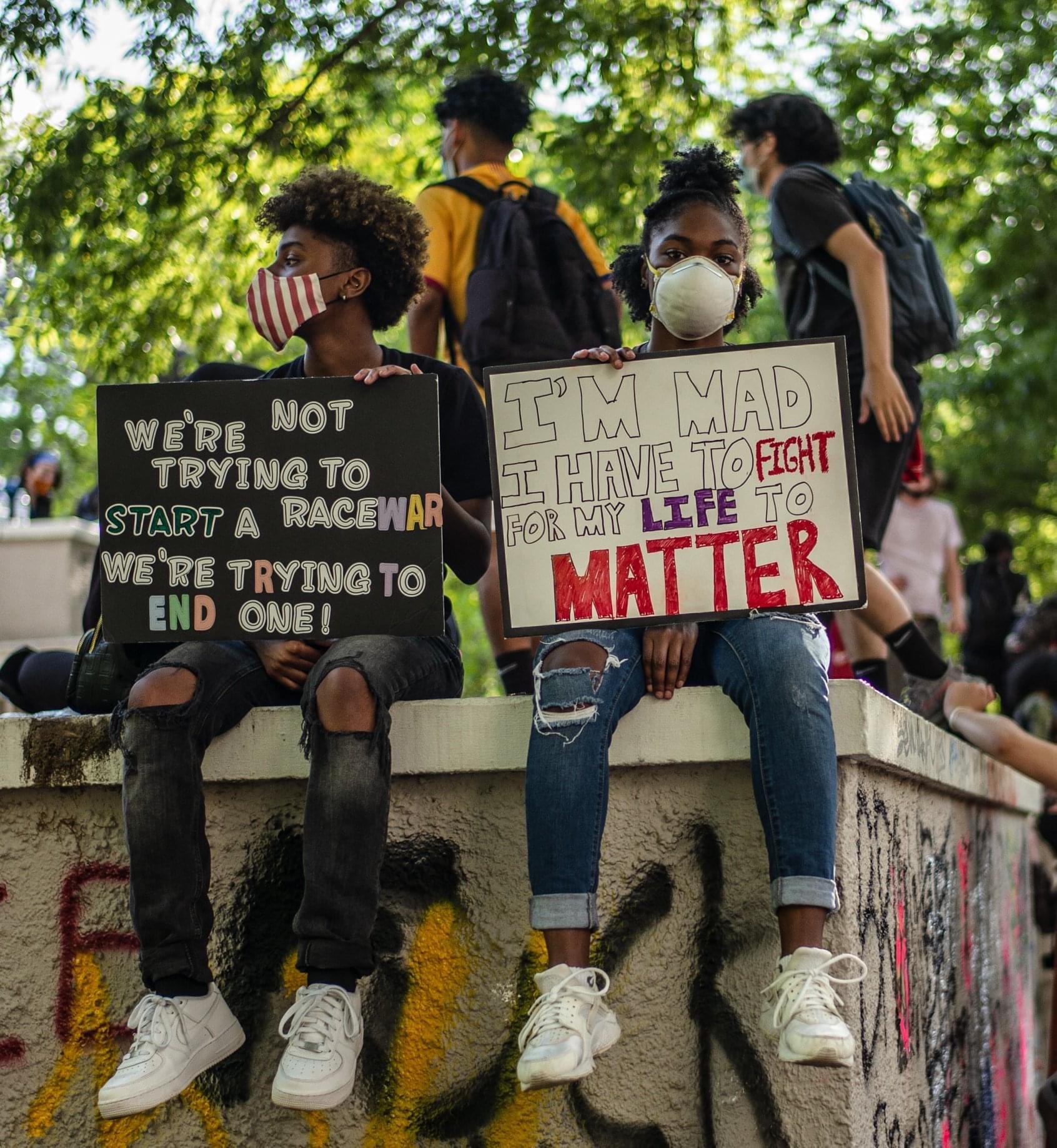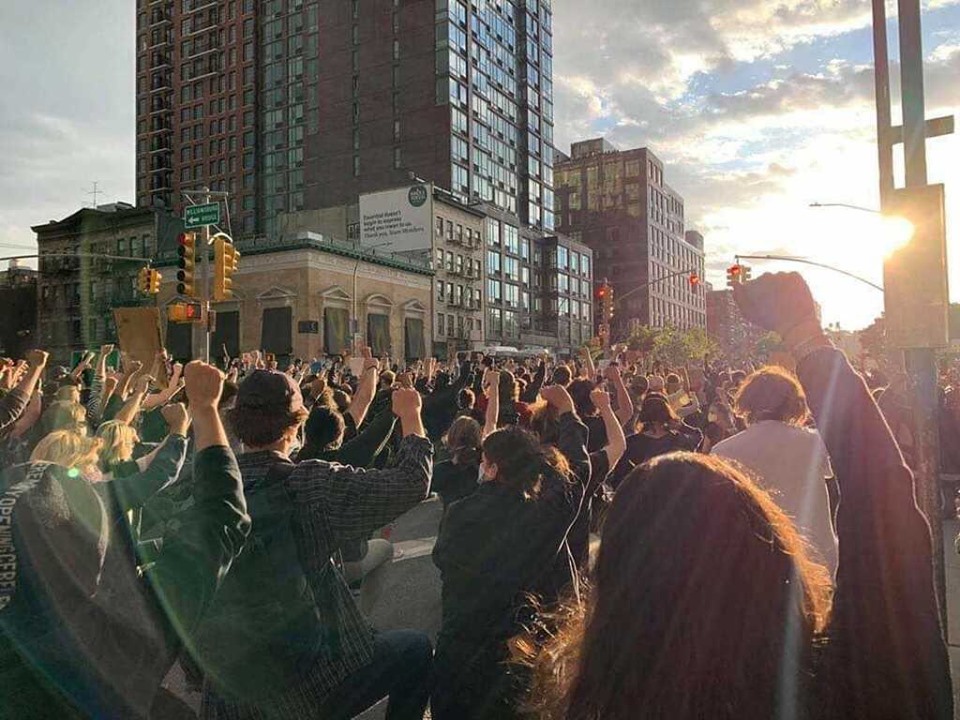Black Lives Matter protests have broken out across all 50 states in the USA following the police killing of George Floyd in Minneapolis. The comrades of Socialist Revolution, the US section of the International Marxist Tendency, have been intervening in many of these protests, fighting on the frontlines alongside workers and youth of all races against the oppressive capitalist system and its murderous state. Only socialist revolution can end racism for good! We will continue to publish reports of our comrades’ activities around this movement in the coming days.
New York City
In NYC, comrades attended a demonstration on Tuesday in Bay Ridge, taking care to observe safety precautions against both the police and COVID-19. When they arrived, the police had already established barricades and were preparing to kettle the 200-strong crowd. Nevertheless, the small, peaceful demonstration marched north on 5th Avenue. The main rally was similarly disciplined, and there were no clashes with the police.
Another rally took place in Union Square at around 7pm. The entire march took the streets but was peaceful. Periodically some marchers would pause and graffiti buildings. Whenever it walked past a bus the bus drivers would honk in solidarity without fail. Some car drivers would honk too, although there was one driver of a BMW who was heckling the protesters.

Comrades also intervened at a demonstration at Foley Square, where approximately 3,000 people were present at its height. Women’s March activist Linda Sarsour spoke to the crowd, followed by Carlene Pinto, who ended by asking people to break the police curfew. Representatives of BLM of Greater NY also addressed the gathering. Additionally, there was a strong presence of mutual aid groups handing out PPE and water. In the afternoon, the protest headed south to protest the Police Plaza. The crowd was energised and people were very receptive to Marxist revolutionary materials and ideas.
In Queens, comrades attended a protest at Jackson Heights. Though the protest was scheduled to begin at 3pm, at that time there were few people within the plaza itself. Many, seeing the pen that the police had created, were wary about allowing themselves to be surrounded. Furthermore, it seemed that many protesters had to commute to the area which may have contributed to the slow start. Eventually more people trickled in but it was not until the protest had left the plaza that a mass began to form.
After around 200-300 people had gathered, the protest began moving around the neighborhood, eventually arriving upon the 115th Police Precinct, which was already barricaded. Once there, the protest organically began using slogans that attempted to divide the police along race and class lines: “are you black or are you blue?”, directed towards black cops specifically; and “quit your job while you still can!”, directed towards the police as a whole.
There were few if any clashes with police and safety seemed to be a top priority. The community, which was unaware of the protest in advance, was pleasantly surprised to see the crowd. Many workers watched from inside their workplaces while others at home banged pots and pans out their windows in support, with some even joining the protest. Our comrades easily sold out of their material, showing the hunger for a revolutionary solution to violence and racism in NYC.
Louisville
The demonstrations in Louisville on 28 and 29 May will go down in local history as a point where all the decades of building contradictions exploded to the surface. They were the biggest demonstrations in Louisville in many years, alongside the climate strike in 2019. Around 2,000 took part.
The protests were relatively spontaneous, with neither being planned out more than 24 hours ahead. The comrades attended with a banner saying “Join the fight for socialism in our lifetime.” Unlike in New York, the police assaulted the crowd. Many were injured and arrested. As of the following morning, at least four people were missing, not registered in any jail. Gunfire was reported within five miles of the city centre, by residents and police dispatch alike. Seven people were shot with live rounds from an unknown assailant at the first of the two protests, and some of the comrades were exposed to tear gas.
Before launching their assault, the police surrounded the medical tent, and isolated it from the protestors. This is both a violation of medical neutrality and of the Geneva Convention: a war crime. A video has also surfaced showing the Louisville police destroying water and milk (for treating the effects of tear gas) brought by the protesters.
The bourgeois press and politicians of Louisville are attempting to slander the protesters, and to get the workers to accept that further police repression is justified. Democratic mayor Greg Fischer published a series of tweets over a 12-hour period showcasing his attempts to walk this delicate line, blaming “out-of-towners & anarchists” for “intending to destroy our city”, leading him to request “assistance from the National Guard.” This was followed by a warning to “stay home” due to COVID-19, before thanking those who “protested peacefully, expressing your concerns about the tragic death of Breonna Taylor” (who was shot dead by police in her own home).
Regarding the claim doing the rounds that “many of the protesters are from out of town”, only two out of the 30 or 40 protesters with whom the comrades at the demo spoke claimed to be from out of town. This is clearly a baseless lie on the part of the bourgeois journalists, used to discredit the protestors seeking justice.
BLM Louisville is currently putting forward demands such as calling on Mayor Greg Fischer to issue a public apology to Taylor’s family and to the entire city, along with a plan of action for “what’s next”, which obviously falls short of what is needed. Nevertheless, and despite the difficulties, there was a lot of sympathy with our slogans and perspectives from the demonstrators, many of whom expressed an interest in learning more about the IMT.
Minneapolis
In Minneapolis, which remains the heart of the protests, the comrades arrived with gloves and masks, with the National Lawyers’ Guild phone number on their arms just in case. A curfew was to be implemented at 8pm. The comrades learned after leaving that they were closing the highways at 7pm, and that also some extreme right-wing/white supremacist groups were rumored to be planning on ‘crashing’ later in the evening. Fortunately, the protest while our comrades were there was perfectly safe and peaceful.
There were perhaps nearly 1,000 people present at the height of the very peaceful protest. There was a labor contingent organized on facebook through a ‘Union Members for #JusticeForGeorgeFloyd’ page. This contingent included the nurse, Cliff, who had been fired for agitating for more PPE at United Hospital, which sparked a picket and march to the Capitol just two weeks ago. He spoke with our comrades and was very sympathetic with our programme.
The police and national guard did not make an appearance. The crowd marched in a large circle around a police department about 3 miles from the 3rd precinct, before camping out at the intersection outside the department with speakers, chanting, some performances, and periodic moments of silence. There were spots all around with accumulated donations of food and water, people walking around distributing water, granola bars and masks and encouraging anyone without one to wear one. Clean up crews have been organized in the neighborhoods. Some small businesses were out giving away free meals like burritos and sandwiches. On the way to the protest, the comrades saw owners of an asian-owned nail salon spraying the boards on the windows of their own shop in support of the protests.
There were plenty of burned buildings on Lake Street, many of which were still smoldering from the night before. Nearly every business in south Minneapolis was boarded up, some of which had been spray-painted by owners with slogans of solidarity with BLM and George Floyd. This may have been because the owners actually believed this, or because they were scared of their shops being looted/burned.
The mood was energetic. All the comrades had to do was hold up their papers and flyers, along with signs making them visible from a longer distance, and people came up to them asking for a copy. Because of the CNN reporter’s arrest there were chants for defending the free press, and this might have contributed to the enthusiasm for our paper.
The thirst for ideas was clearly shown a block away from the protest where a local journalist speechified to a seated audience of 20 or more people, arguing for more organization of protest and urging ’system change’. Some of the chants were “arrest all four”, “no justice no peace, no racist police,” and “a few bad apples spoils the bunch.” We would say there are no good apples! No police! “Arrest all four” has become the main demand of the movement, with some speakers even saying we will go home when the four policemen involved in George Floyd’s murder have been arrested. But why stop there? If the movement retreats, the killer cops might get leniency. And until the capitalist system falls, racism will continue.
Comrades and sympathisers report that local activists have taken it upon themselves to keep their communities safe. On the way back from the protests the comrades saw sprayed onto a boarded up restaurant “community patrol 4 our safety.” The idea of neighborhood defense committees is naturally starting to catch on. From the police repression, the threat of the far-right, and agent provocateurs, the masses are learning they can only depend on their own forces to keep themselves and their communities safe.
These spontaneous bodies responded to two cars crashing into a barricade; prevented people breaking into banks, malls and small businesses; checked on vulnerable neighbours and relocated them to hotels if necessary; cleaned the streets; and chased far-right thugs out of town.
These bodies should be built on and put on an organised basis, becoming official neighbourhood defence committees answerable to the working people of Minneapolis. A network of such committees should be established throughout the United States, to democratically plan the direction of the movement.
North Carolina
Comrades intervened in a demo at Raleigh/Durham on 30 May, at which they were the only group present raising explicitly anti-capitalist slogans. The comrades’ signs were very well received, particularly: ‘You can’t have capitalism without racism”. On several occasions we heard people reading our signs aloud and saying “That’s right!”, or “the Truth!” The crowd shouted back things like: “Capitalism is the problem!” “American capitalists kills” “fuck the racist money system!”
At a certain point, the cops started tear gassing everyone. Our comrades were running away to the side streets, but even there the police gassed the retreating comrades. After the tear gas, the mood had changed. Cop teams came running in with batons and our comrades were forced to leave the protest.
Los Angeles
The protest began at Pan Pacific Park, and marched along 3rd street, to Burton Way, to Rexford Dr. (past the Beverly Hills Police Station), then from Sunset to Rodeo. The march then looped from Wilshire, back to Sunset, and followed roughly the same route back. The details of the march route are important because these were not pre-closed and fenced streets or parks of Downtown Los Angeles. These were some of the busiest streets in the city in some of the wealthiest neighborhoods of the city, and they were shut down for almost 6 hours as protesters marched a total of 7 miles. This is a much farther distance than approximately ¾ of a mile from Pershing Square to city hall, the most common march location and route that has been used by the annual Women’s March since 2017.
There are several observations that the comrades noted about the march and the violent repression it faced at the end of the evening. All along the march route, the most prominent forms of damage that were noted was simply some graffiti tagging. Most commonly these tags said “BLM”, “FTP”, “ACAB”, “FUCK 12”, “FUCK KKKOPS”, etc. However, there were several tags of a more revolutionary character such as “Fuck Profit,” “The Guillotines are Coming,” “Amerikkka must pay for its crimes against black lives,” and others. Hammer-and-sickles and the anarchist Circle A were often tagged too. While the most direct outlet of the anger was targeted specifically at the police and the racial injustice wrought against black and brown Americans, there was a definite layer of inherent feeling that it isn’t just an issue of racist cops, but an issue of a deeply flawed and outdated capitalist system that law enforcement protects. This was shown most clearly at one of the most significant points of the march, where it was stopped on Rodeo Dr. in the absolute heart of Beverly Hills. The crowd spontaneously erupted into chants of “Eat The Rich”.

Our ideas were met with enthusiasm and the comrades were easily able to hand out all of their leaflets. Unfortunately, people proved understandably hesitant to give information to them. It is believed that this was partially a result of the fear of potential police agents hidden within the crowd, as well as the loud slogans being constantly yelled and the fast-paced nature of the march.
As the march returned close to its point of origin, Pan Pacific Park, the LAPD (who had been largely absent for this march, save helicopters flying overhead) set up phalanxes of riot cops who herded protesters into a parking lot next to the Grove Mall (a large and expensive shopping mall) and a Whole Foods. Before this point, before the crowd reached the intersection 3rd and Fairfax, a cumulative total of 7 miles and 6 hours of marching had passed with few incidents of violence from the marchers. There was one instance of attempted looting, which was quickly decried and condemned by the adjacent crowd, to the point where the attempted looter became frustrated and walked away empty-handed. At the corner of 3rd and Fairfax, a standoff with the police began to develop, a standoff the overwhelming majority of the crowd was determined to keep peaceful and non-violent, at least from the side of the protesters. The occasional water bottle was thrown towards the cops, but this was swiftly decried and tensions assuaged. It became clear that, for almost 30 minutes, the crowd, with their hands up, chanting “Hands up, Don’t Shoot” had the cops on the retreat.
Unfortunately, due to a mix of a variety of factors including growing anger at the provocative riot cops and undercover police provocateurs; tensions began to build to a breaking point. Cops pressured the protesters east, down 3rd Street, and toward the Grove Mall. Finally, when windows of the Whole Foods were broken, the riot cops moved in and started shooting tear gas and rubber bullets and pushing the protesters out of the parking lot and onto 3rd street. Even still, the protesters on 3rd street were determined to hold a peaceful line, and were successful for a time. But the police continued to push in on 3rd Street with tear gas and rubber bullets, causing the crowd to scatter. While the specifics of the street location and the direction of the cops may not seem significant at first, it is important to note that the arrangement of police and protesters meant that the only way for the protesters to scatter was into The Grove. At this point, looting began to occur.
It is clear that the working class, especially the youth, are fed up with the systemic oppression prevalent in this system. The march also showed the strength of the working class, especially acting in a unified and organized manner. The streets utilized on the march would never have been approved for shut down by the city, but the protesters did it anyway, and they for more than a quarter of the day. The violence that occurred at this protest lies directly at the feet of the police. They acted in a concerted manner to get the exact result they wanted. They could have easily greeted the returning marchers by blocking us from the Grove, yet they chose to scatter us into it, leading to looting. Had the police never showed up, the protest would have almost certainly returned to Pan Pacific Park, and would have peacefully dispersed from there.
We know this because even when the protest marched down some of the wealthiest streets in the entire world, no one attempted to break windows or loot stores. As vandalism continued to occur it happened exclusively on the storefronts of wealthy businesses or public vehicles like the postal service or buses and only took the form of graffiti. No one touched the private cars that occasionally dotted the march route, including an angry Beverly Hills driver who drove through the crowd without warning on Burton Way (no one was hurt). The police, and the police alone, are responsible for the damage that occurred.
Ferguson
A few hundred people gathered in Ferguson, Missouri for a protest on 30 May. Protestors were scheduled to meet at the Ferguson Police Department at 6pm. Earlier in the day, the Captain of the police got the crowd to kneel with them. This was a typical cynical and opportunist ploy on the part of the Police Captain to get the people to play “Simon Says” with the police while alluding to Kapernick’s kneeling in protest against police brutality against black Americans during the National Anthem. The leader (with the loudspeaker) took her lead from the police captain asking people to sit and kneel for the first hour or two of the protest. At one point a couple people in the crowd hollered out “why you keep askin’ us to sit down? We been sittin’ down all day. We’re sick of sittin’ down…” It was clear that the leadership was not only being unhelpful. They were actually holding people back; even taking their lead from the police!
Eventually, everyone stood up, and then some guy ran across the lot (probably just a coincidence that these things happened at the same time but hard to tell) and hopped the fence, entering the police parking lot. Everyone was clapping and it was hard to tell what was going on.
From the station, starting around 7:30, the crowd marched down the street and blocked an intersection for a while. While there they received signs of solidarity from many drivers (e.g., hand signals, cheering, clapping and honking) including a notable instance of a bus driver who clapped and honked his horn for the crowd. The protestors also made way for drivers occasionally when necessary. All of this was conducted in a relatively organized manner. Then the protesters returned to the station. After the official protest was declared finished, things heated up. People bashed out the windows and set off many rounds of fireworks in the parking lot where the police were positioned. At one point a protestor actually set them off in the police building where one of the windows was shattered. At this point they sent in the riot cops who retaliated with tear gas grenades.
Throughout the protests, these were the most popular chants:
“Who shuts shit down? We shut shit down!”
“I can’t breathe!”
“FTP!” “Fuck the police!”
And a couple of times: “All power to the people!”
Colorado Springs

The protesters marched from city hall to the police station. There, the police were asked why they were already in riot gear to which there was no response. The crowd then asked the police to take a knee with them as they all took a knee, in solidarity with those who have been murdered by police officers. They refused. One officer noted she wished she could join… a sign that morale among the police is falling, but after pleading with her to join the protesters she clammed up. The crowd asked for a police escort after one officer claimed they were here to keep them safe, they denied this as well. This created some tension with protesters who decided to march back to city hall. All the while drones flew overhead capturing pictures and police snipers lined the rooftops.
Upon reaching city hall the crowd shut down the main intersection nearby, redirecting traffic, which was mostly safe save for an angry and aggressive driver that almost ran over a couple protesters.
They then marched back through the streets of downtown Colorado Springs to the police station. Protesters eventually passed the barricade during a standoff. They pleaded with the police again to take a knee, chanting “TAKE A KNEE AND WE WILL LEAVE", to which the cops again refused due to “safety reasons”. Things remained peaceful for a time until someone threw a firework at police, which prompted one officer to shoot an unarmed young african american man in the face with a rubber bullet, knocking him unconscious in a pool of blood. The line broke for a time, and was reformed. Medics with armed guards (non-state) brought the victim to a safe location. Arrests were made, and more fireworks and water bottles were thrown before the comrades retreated.
Denver
Finally, in Denver on Friday, comrades intervened at a 12pm rally at the Capitol Building. They were immediately told to stop by a Denver city employee so decided to hand out posters instead. The protests were peaceful. About 200 people gathered, then marched onto Civic Center, and then onto the city courthouse before marching down to the 16th Street mall. When possible, the organizers kept protestors from blocking streets. After marching to the end of the mall, the protesters turned around and headed back to the capitol, by which time the crowd had doubled in size. The comrades approached people asking, “do you want a workers’ party?", which was well received.
On Saturday, there was another protest at the capitol, and people gathered in groups totalling about 600 people all over the city park. The comrades began asking people if they wanted a revolution. Every single person said yes. The youth and teenagers in particular were extremely enthusiastic about Marxism. At around 4:30, a march started, with the crowds chanting the slogan: “we want justice, fuck your curfew!” There was some disruption and confusion, with loud bangs and different groups running in different directions, but the protest was mostly disciplined.
On Sunday, a crowd had gathered in front of the footsteps of the capitol building. The comrades set up a table approximately 50 feet away from the steps at the front of the building.
Overall the people seemed convinced of what they want, but confused about how to get it. There is a lack of organization, but the will for revolutionary action is palpable!

